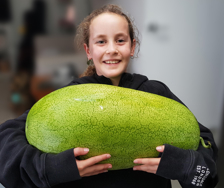You could almost say they are as a cool as a cucumber!
As this is the first year with a greenhouse, we are trialling some cucumbers in the greenhouse to see how they go. I've cable tied some fencing wire to the roof as a temporary support as I believe we will be constantly changing what we grow in the greenhouse.
What I'm most excited about is the variety. We are growing two types of F1 Hybrids which are parthenogenic (don't need fertilisation to produce fruit). This is awesome as I've not yet seen a bee in the greenhouse even though the door is open. They are true to the label and are producing fruit. If I'm correct, every cucumber should form meaning a good crop with little effort.
I'm a big fan of F1 hybrid seeds but feel that heirloom seeds need to be protected as well. If you are unfamiliar with F1 hybrids, they are not genetically modified so nothing freaky is going on.
I found this explanation on the net which makes it clear.
F1 hybrid seeds refers to the selective breeding of a plant by cross pollinating two different parent plants. In genetics, the term is an abbreviation for Filial 1- literally “first children.” It is sometimes written as F 1, but the terms mean the same.
So effectively an F1 hybrid is the offspring or seeds from two different plants which are cross pollinated. Technically this could happen in nature but it is done in a controlled environment.
By cross pollinating plants, the offspring have different traits to their parent plants or some traits from each parent (kinda like Haven has some of my traits and some of mums). Plants are bred this way for desirable traits such as disease resistence, more fruit, ease of pollination or better taste.
The downside is that any seeds you collect from the fruit of an F1 hybrid is likely to be largely different from the plant you grew so for this reason we do not collect the seeds.
We will be growing mostly F1 hybrids for our tomatoes and specifically ones that are bred to be tolerant to late blight.
Science is pretty cool.
The reason I say heirloom seeds to be protected is because it is still very important to have some of the original plants that perform well and their seeds can be collected for future generations.










Share
Share this blog on social media